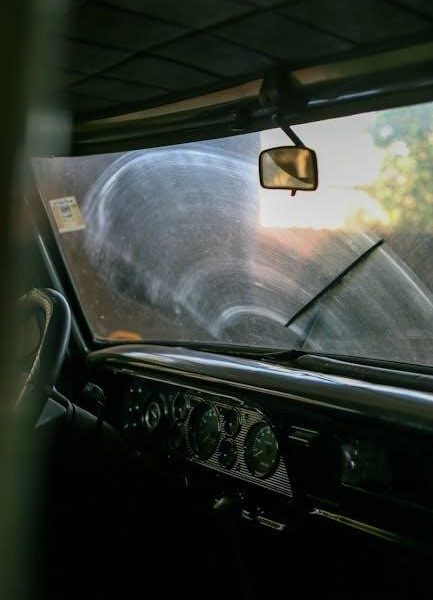Mercedes-Benz has a history with manual transmissions, offering them in various models. These manual options were primarily found in their compact range and some sedans; Notably, Mercedes-Benz produced their own transmissions for many years, showcasing a commitment to in-house engineering.
Historical Overview of Mercedes Manual Transmissions
Mercedes-Benz’s journey with manual transmissions is a long and storied one, dating back to the early 20th century. For decades, manual gearboxes were a staple in their vehicle lineup, reflecting the era’s engineering norms. These transmissions weren’t just a standard offering; they were a part of the brand’s identity, particularly in models that emphasized a more connected driving experience. Throughout the mid to late 20th century, Mercedes offered manuals across various models, from smaller sedans to sporty coupes. This option catered to drivers who preferred a more hands-on approach to shifting gears, allowing for greater control and engagement. The presence of these manual transmissions highlighted a different aspect of the brand, one that was about driver involvement as much as luxury and refinement. Over time, as automatic transmissions became more sophisticated and popular, the manual option began to wane, but its legacy remains an important part of Mercedes-Benz’s history.
Mercedes 6-Speed Manual Transmission (711.6)
The Mercedes 711.6 is a 6-speed manual transmission designed for front-wheel drive vehicles. This gearbox is a fully synchronized, three-shaft design, featuring six forward gears and one reverse gear. It was engineered for transverse mounting, making it suitable for the company’s compact models. The 711.6 transmission is a product of Mercedes’ in-house engineering, reflecting their expertise in drivetrain technology. This particular transmission was often paired with smaller displacement engines, providing a more engaging driving experience in the A-Class and B-Class models. The fully synchronized nature of the gearbox allows for smoother and more precise gear changes, adding to the overall driving pleasure. Its design is focused on efficiency and durability, ensuring reliable operation over the lifespan of the vehicle. Although manual transmissions are becoming less common, the 711.6 remains a notable piece of Mercedes’ engineering history.
Models with Manual Transmissions⁚ Compact Range
Mercedes-Benz offered manual transmissions primarily within its compact range of vehicles. This segment included models like the A-Class and B-Class, where the option of a manual gearbox was more common. These models often featured smaller displacement engines paired with the 6-speed manual transmission, providing a more engaging driving experience for enthusiasts; The compact range was the main focus for manual transmissions in the Mercedes lineup, as larger models in the C-Class and above rarely featured this option. The decision to offer manuals in the compact range was aimed at a specific segment of drivers who value the connection to the road and the control offered by a manual transmission. While the availability of manual transmissions has diminished over time, their presence in the compact range is a notable part of Mercedes’ history. The A160d, A180d and B180d are examples of models in the compact range that offered a manual transmission option.
Specific Models⁚ A-Class and B-Class
Within the Mercedes-Benz compact range, the A-Class and B-Class models stand out as specific examples where manual transmissions were offered. These vehicles, particularly the A160 d, A180 d, and B180 d, were often equipped with a 6-speed manual gearbox, paired with a 1.5-liter Renault engine modified by Mercedes. This combination provided a more engaging driving experience, appealing to those who prefer the control of a manual transmission. The A-Class, available in both hatchback and sedan variants, and the B-Class, a more spacious compact MPV, both catered to different needs but shared the option of a manual transmission. This option was a key feature for those seeking a more traditional driving experience within the Mercedes lineup. The manual transmission availability in these models highlights Mercedes’ efforts to offer variety and cater to different driver preferences within their compact segment.
Engine and Transmission Pairing
The pairing of engines and manual transmissions in Mercedes-Benz models primarily focused on the smaller displacement engines, particularly in the compact range. A notable combination was the 1.5-liter Renault engine, modified by Mercedes, paired with a 6-speed manual gearbox (711.6). This setup was commonly found in models like the A-Class and B-Class, offering a balance between efficiency and driver engagement. The manual transmissions in these models were designed to be transversely mounted on front-wheel-drive vehicles. This configuration allowed for a compact and efficient powertrain layout. While larger engines were typically paired with automatic transmissions, the manual option was specifically reserved for smaller engines to cater to a different segment of the market, emphasizing control and direct engagement. This pairing was a deliberate strategy to offer a more traditional driving experience in their compact models. The manual transmission was a three-shaft gearbox, fully synchronized, with six forward gears and one reverse gear.
Mercedes Manual Transmission Availability by Year and Model
Mercedes-Benz manual transmission availability varied significantly across different years and models. Historically, manual transmissions were more common in earlier models, including those from the 1990s and early 2000s. The 190 series, for instance, offered a 4-speed manual option. In the following decades, manual options were primarily concentrated in the compact range, particularly the A-Class and B-Class. Models such as the A160 d, A180 d hatch, A180 d sedan, and B180 d were available with a 6-speed manual transmission. However, the availability of manual transmissions gradually declined in the late 2010s and early 2020s, with the brand ultimately phasing them out in 2023. The C-Class and SLK/SLC models were among the last to offer manual options. The SLK roadster, for example, was available with a manual transmission until its transition to the SLC, when the option was discontinued. This availability was also market-dependent, with some markets having access to models not available elsewhere. The trend shifted towards automatic-only transmissions in Mercedes’ lineup.
End of Manual Transmission Production in 2023
Mercedes-Benz officially ceased production of all manual transmission models in 2023, marking the end of an era for the brand. This decision was part of a broader strategy to transition towards an automatic-only lineup. The discontinuation affected the remaining models in the A-Class, B-Class, and CLA-Class ranges, which were the last to offer manual options. This move made Mercedes-Benz one of the first major automotive manufacturers to completely abandon manual transmissions. The decision reflects a shift in consumer preferences towards automatic transmissions and advanced driver-assistance technologies. While manual transmissions were once a staple in the automotive industry, their popularity has waned over time, leading to their decline. The 2023 cutoff signifies Mercedes’ focus on innovation and the adoption of more modern technologies. The end of manual transmission production also means that Mercedes enthusiasts who prefer manual models must now turn to the used market to find vehicles with this configuration. This shift towards automatic transmissions has also been observed across other car manufacturers.
Mercedes Transition to Automatic-Only Strategy
Mercedes-Benz’s decision to transition to an automatic-only strategy reflects a significant shift in the automotive landscape. This move, finalized in 2023, marked the complete elimination of manual transmissions from their new vehicle lineup. The transition was driven by several factors, including declining consumer demand for manual transmissions and the increasing sophistication of automatic gearboxes. Mercedes-Benz aimed to streamline production and focus on developing advanced automatic transmission technologies. This strategy also allows for better integration of driver-assistance features and improved fuel efficiency across their model range. The move towards automatic-only vehicles also aligns with the broader trend in the automotive industry towards increased automation and digitalization. While the decision may disappoint some enthusiasts, it underscores Mercedes-Benz’s commitment to innovation and its focus on providing the best possible driving experience through advanced automatic transmission technologies. The automatic-only strategy positions Mercedes-Benz as a leader in embracing modern automotive trends and adapting to changing market demands.
Specific Models Offering Manual Transmissions
While manual transmissions were once a more common feature in the Mercedes-Benz lineup, their availability has steadily declined. Certain models, primarily within the compact range, were the last to offer this option. The A-Class and B-Class, particularly the A160 d, A180 d hatch and sedan, and the B180 d, were equipped with a 6-speed manual transmission paired with a 1.5-liter Renault engine modified by Mercedes. These models represent some of the final Mercedes vehicles to feature a manual gearbox. Additionally, the C-Class sedans and the SLK roadsters also offered manual transmission options, further highlighting the variety of models previously available with manual gearboxes. The SLK, later known as the SLC, featured a manual option in earlier models. These examples represent the range of Mercedes vehicles that once offered the choice of manual shifting, before the company’s transition to an automatic-only strategy, which resulted in the discontinuation of manual gearboxes across their entire model range.
C-Class and SLK/SLC
Within the Mercedes-Benz lineup, the C-Class and the SLK/SLC models represent a specific segment where manual transmissions were offered. The C-Class sedans, in particular, were known to have a manual transmission option, providing an engaging driving experience for enthusiasts. These cars, often equipped with six-speed manual gearboxes, allowed drivers more control over gear selection. The SLK roadster, which later evolved into the SLC, also featured manual transmissions in its earlier iterations. The SLK, which stood for sporty, light, and short, was a sporty option that offered this feature. However, with the transition to the SLC, manual transmissions were phased out in favor of the 9G-Tronic automatic transmission. The early R172 versions of the SLK, with their turbocharged inline-four engines, mark some of the last Mercedes roadsters to offer a manual option. This combination of C-Class sedans and SLK/SLC roadsters represents a period when Mercedes offered manual gearboxes in their more compact and sport-oriented vehicles before ultimately shifting to an automatic-only strategy.
Current Market Share of Manual Transmissions
The current market share of manual transmissions, particularly in the context of Mercedes-Benz, is quite small. Manual-shift models now account for a very minimal percentage of new vehicle sales, with figures hovering around just 2%. This reflects a broader trend in the automotive industry where automatic transmissions have become the dominant choice. While manual transmissions were once a standard offering, their popularity has waned significantly due to factors like the increasing sophistication of automatic gearboxes and the desire for more convenient driving experiences. This decline is evident even in brands like Mercedes-Benz, which previously offered manual options in a significant portion of their model lineup. The shift towards automatic-only strategies, as seen with Mercedes, further highlights the dwindling market share of manual transmissions. This trend shows a preference for automatic transmissions, even in brands that were known for offering manual gearboxes to driving enthusiasts. This trend underscores the limited current demand for manual transmissions in the broader automotive market.

